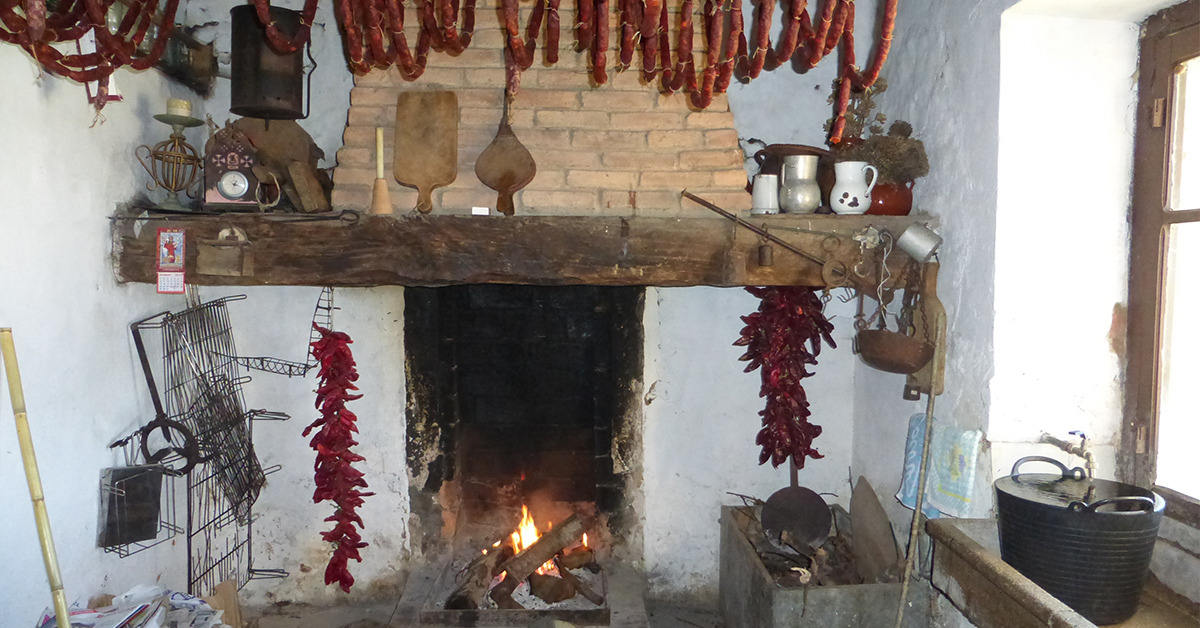Basque ethnography at a glance

Traditional fireplace. Larrabetzu (Bizkaia), 2014. Photo credit: Akaitze Kamiruaga. Labayru Fundazioa Photographic Archive.
The kitchen —ezkaratza, as we know it in Gernika and environs— used to be and still is the heart of any home, a lit fire being the essential life-giving element within it, where food was cooked, for folks and animals, and where heat radiated from. Around the domestic fire, family scenes were commonplace, countless old stories were told, and knowledge would be passed on from generation to generation.
To build a traditional fireplace (beheko sua), a three-sided frame made of chestnut wood or oak heartwood was needed. Two parallel pieces of timber were nailed to the wall, a third joined them, and all three were underpinned, to prevent collapse. The firebox was built with brick and mortar, as are partition walls. The hearth, however, was made of cast iron —since wrought iron would bend— and mounted on a raised floor. Usually decorated with either religious or profane engravings, such as the Tree of Gernika, the firewall (txapea) was also made of cast iron, and in some cases of sandstone.
From an iron crossbar in the upper central part of the smoke chamber, an iron chain (laratza) hung, with a hook at the bottom and at the top. And cauldrons and pans dangled from the lower hook directly over the flames.
The oldest fireplaces with no chimney to channel smoke featured a wooden device consisting of a vertical beam, bolted to the ceiling, and a horizontal one, free to rotate, from which a long chain and a hook were suspended, allowing it to be dragged to the centre of the room, so that the cauldron hanging on it could easily be swung away from the fire. These timber beams were often withered by the heat and turned as black as soot (kedarra). And on the wall, the welcoming light of an oil lamp would brighten up the otherwise dark and sombre kitchen.
Multiple types of cauldrons and pans were hung on the hook of the chain: the one containing hot water, which could be needed at any time to do the washing up or the laundry, the one for boiling milk, the one for preparing the pig’s food or the one for scalding black pudding. Such vessels were made of zinc or copper and bought in shops.
Trivets (treberak) for pots or pans to stand on and a grill (parrillea) for roasting meat, fish or even apples over the glowing embers (txingarrak) were widely used. A wooden board for flattening maize pancakes (talo-ohola), a metal shovel for baking them (talo-burdinea), a roasting spit (burduntzia), a chestnut roasting drum (tanbolina), a pair of bellows (hauspoa), and a pair of tongs (tenazak) were other everyday accessories.
In times when there were no matches, or they were scarce, embers would be covered with ash and preserved until the following day. Thin branches were added to revive the fire, blowing air into it with the bellows if necessary. Arbutus (gurguxea) makes excellent firewood, we are told, because it gives off lots of heat, burns cleanly and produces little smoke. Cherry, holm oak, oak, white-skinned juniper, acacia and apple wood are also suitable. Fig wood is not at all appropriate for heating though, and chestnut wood gives a dull flame.
The mantelpiece above the fireplace was typically ornamented with a red or blue chequered cloth, or overhanging decorative paper edging. It was customary to rest a candlestick, a chocolate pot or a jug on it. And a wooden armchair (txixilua) and some chairs were placed on each side of the fireplace. It truly felt like heaven there by the fireside.
Segundo Oar-Arteta – Labayru Fundazioa
Translated by Jaione Bilbao – Ethnography Department – Labayru Fundazioa
Reference for further information: House and Family, part of the Ethnographic Atlas of the Basque Country collection.

